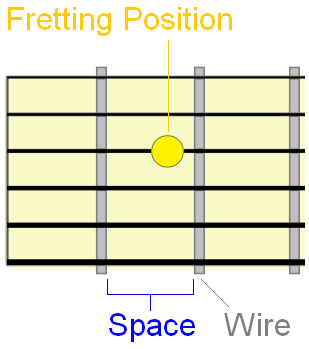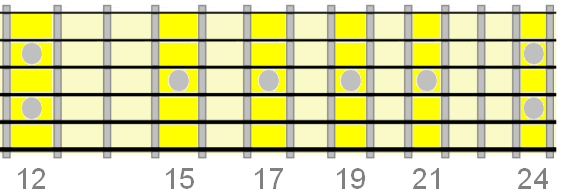Fretboard Basics #1 - Frets and Inlays
Your guitar's fretboard has a
sequence of raised metal wires called frets. Most
electric guitars have 21, 22 or 24 frets and acoustics tend to have 20.

Each fret represents a new note for each
string, but when we come to press our fingers on the
fretboard,
we actually use the spaces
in between the fret wires to create the
note, not the wire
itself.

For example, pick any fret and the space before that is the area that creates the note when applying our fingers.
So when we refer to the 2nd fret or 6th fret we are actually referring to the space just before the actual fret wire. Because of this, guitarists tend to think of "frets" as the spaces rather than the wire.
We'll look at finger positioning in the chord basics lessons. But when fretting, ensure your finger is as close to the fret wire as possible/comfortable, without actually being on the fret wire. This will give you the clearest sound.
You'll notice on your guitar's fretboard there are inlay markers, either dots or symbols at particular fret intervals. Most commonly, these are found at frets 3, 5, 7, 9 and 12.
The 12th fret marker is often more prominent than the others (e.g. 2 dots instead of 1, or something more decorative). We'll see why the 12th fret is particularly significant in a moment.

Once we get beyond the 12th
fret, the pattern of inlays repeats itself. So, the inlay markers will
be at frets
15, 17, 19,
21 and 24 if your
guitar accommodates
it.

It's a good idea to learn these inlay positions
and their corresponding fret numbers to start with (that was a hint!).
Fretboard Basics #2 - Open Strings & Octaves
Your guitar will most likely have 6 strings (sorry, this site doesn't cover guitars with 7 or more strings... yet!).
From low to high (low being the lowest sounding, thickest string) we have:
E A D G B and e (small "e" representing the higher pitch).
This is known as standard tuning and is by far the most common guitar tuning.
Note: You'll often see/hear people refer to the strings with numbers. From the lowest/thickest string we have: 6th, 5th, 4th, 3rd, 2nd and 1st (thinnest string).
Playing any of the strings without pressing any
fingers on the fretboard is known as playing the string
open.
So an open string is basically an unfretted string (e.g. open E, open
A, open D etc.).
Now, here's where the 12th fret comes in - if you play any of the 6 strings open, then press that same string at the 12th fret, you get the same note but what is called an octave higher. This means the equivalent of "12 frets higher" or "12 semitones higher".

You will better understand why this is as you progress, but in short there are 12 notes in total in the musical alphabet. Once you get passed the 12th note, the alphabet repeats, with the higher pitched octave notes. More on this another time!
If your guitar has 24 frets, the 24th fret will be an octave higher than the 12th fret, and therefore two octaves higher than the open string!
This also means that notes/frets past the 12th fret will be an octave higher than their corresponding lower fret for each string.
For example, the 13th fret is an octave of the 1st fret for each string. The 17th fret is an octave of 5th fret. Try and learn all the corresponding octaves past the 12th fret as you'll be referencing these all throughout your guitar playing life.
We'll be looking more at what we actually call the notes in between the open - 12th fret - 24th frets in a later fretboard lesson. For now, though, just ensure you can identify the open strings, the fret numbers and their octaves beyond the 12th fret.

Numbering your frets is also beneficial when it comes to reading guitar tab (the above form of notation for guitar), it basically shows you at which fret numbers you need to press your fingers for each string.
In the next part, we'll start learning the note names on each fret - a hugely beneficial use of your time in these early stages. But spend all the time you need on this lesson first. No rush! Keep your time balanced between this stuff and learning any songs you like.
Want a head start with mastering the fretboard? I highly recommend taking a look at Guitar Notes Master.

